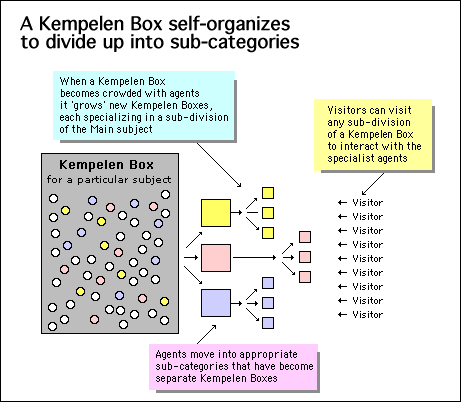

Tracking trends

The advantage of having a Kempelen Box based upon agents rather than a database is that the system can be allowed to grow and self-organize organically. The diagram above shows how this happens.
When a Kempelen Box starts to become crowded with agents, another Kempelen Box can be created. This new Kempelen Box can take from the original Kempelen Box all the agents that seem to be concentrating upon a particular sub-section of the subject. For example, if the subject was 'Web site design', a new Kempelen Box might 'grow' out of the original, taking with it all the agents whose information related mainly to 'programming'.
This would then become a completely independent Kempelen Box, attracting experts and visitors whose prime interest was in programming languages and techniques. If this also became crowded with agents, it too could 'grow' a new Kempelen Box - perhaps taking all the agents who were providing information on working with XML.
In this way the expansion of any Kempelen Box would result in the 'growth' of new Kempelen Boxes, related to each other in a hierarchical way. This hierarchy wouldn't have to be pre-planned into the system, it would emerge naturally. This is one of the ways in which stigmergic system Web sites self-organize.
As you'll realize, this growth pattern can take unpredictable directions. The hierarchical organization and the categorization are not pre-determined but emerge as a result of visitor and agent interaction. This is the way stigmergy works.
Such an organically growing system can have many benefits because it effectively tracks the changing interests of both users and experts. This allows developers of products and services to pick up on new trends.
Note: This can be likened to the way in which the discovery of a new source of food in the locality of an ant nest will change the pattern of the pheromone trails.
One of the main objectives of our current research is to initiate these organically growing Kempelen Boxes and study the way in which they develop.